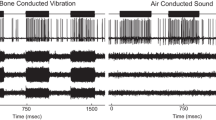Abstract
The SP/AP ratio is a commonplace measure used in cochleography for detection of Meniere’s disease (a pathology of the vestibular system). The measure is usually an averaged response to an acoustic stimulus. Franz described a process whereby the vestibular response rather than the cochlear response was used to elicit the SP/AP ratio. This paper examines that direct process. The direct process appears to detect a driven vestibular response, probably from the semicircular canals, at about 15Hz.
Similar content being viewed by others
References
Hain, T.C., ECOG Testing, 2004. http://www.dizziness-andalance. com/testing/ecog.html. 2004.
Devaiah, A. K., Dawson, K. L., Ferraro, J. A. and Ator, G. A.,Utility of area curve ratio electrocochleography in early meniere disease, Arch Otolaryngol Head Neck Surg. 129(5): 547–551, 2003.
Franz, B.,A method of measuring the activity of a biological System, Patent, International publication number WO 02/47547 A1. 2002.
Baloh, R. W. and Honrubia, V.,Clinical neurophysiology of the vestibular system, 3rd ed., Oxford university press, New York, 3–49, 2001.
Guyton, A. C. and Hall, J. E.,Textbook of medical physiology, 10th ed., Saunders, Philadelphia, 640–646, 2000.
Silverthorn, D. U.,Human physiology: an integrated Approach, 2nd ed., Prentice Hall, Upper Saddle River, 306–308, 2001.
Fife, T. D., Tusa, R. J., Furman, J. M., Zee, D. S., Frohman, E., Baloh, R. W., Hain, Goebel, T. J., Demer, J. and Eviatar, L.,Assessment: vestibular testing techniques in adults and Children, Neurology. 55: 1431–1441, 2000.
Hess, K., Baloh, R.W., Honrubia, V. and Yee, R.D.,Rotational testing in patients with bilateral peripheral vestibular disease, laryngoscope. 95: 85–88, 1985.
Bear, M. F., Connors, B. W. and Paradiso, M. A.,Neuroscience, exploring the brain, 2nd ed., Lippincott Williams and Wilkins, Baltimore, 488–489,611, 2001.
Foffani, G. and Priori, A.,300-Hz subthalamic oscillations in Parkinson’s disease, Brain. 126: 2153–2163, 2003.
Goncharova, I. I., McFarland, D. J.,Vaughan, T. M. and Wolpaw, J.R.,EMG contamination of EEG: spectral and topographical characteristics, Clinical Neurophysiology. 114: 1580–1593, 2003.
Hagemann, D., and Naumann, E.,The effects of ocular artefacts on (lateralized) broadband power in the EEG, Clinical Neurophysiology. 112: 215–231, 2001.
Chung, W. H.,Clinical usefulness of extratympanic electrocochleography in the diagnosis of Meniere’s disease, Otol Neurotol. 25: 144–149, 2004.
Foffani, G., Priori, A., Rohr, M., Presenti, A., Locatelli, M. and Caputo, E.,Event-related desynchronization (ERD) in the human subthalamus and internal globus pallidus, Journal of Physiology. 539: 39P, 2002.
Cohen, M.,Bioenergetics, information and acapuncture: an exploration between acapuncture, information and bioelectromagnetism, PhD thesis. Electrical and computer systems engineering: Monash University, 116–118, 2000.
Author information
Authors and Affiliations
Corresponding author
Rights and permissions
About this article
Cite this article
Shoushtarian, M., Lithgow, B. A vestibular diagnostic response. Australas Phys Eng Sci Med 27, 189–198 (2004). https://doi.org/10.1007/BF03178648
Received:
Accepted:
Issue Date:
DOI: https://doi.org/10.1007/BF03178648




